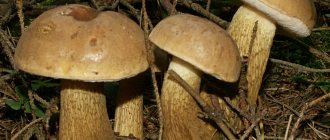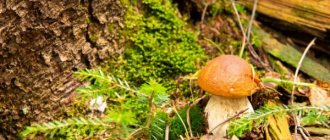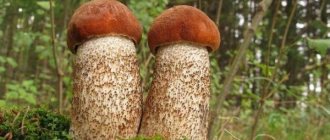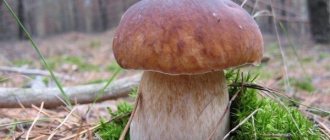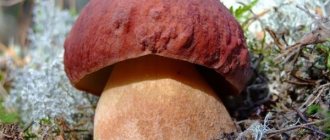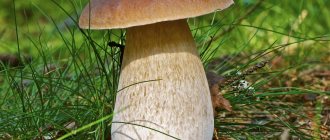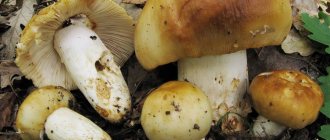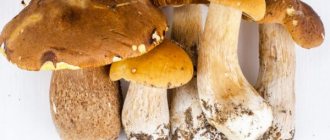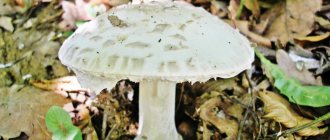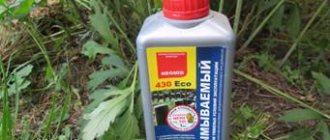Contrary to popular belief, it is indeed possible to confuse porcini mushrooms with their poisonous counterparts, despite the fact that boletus mushrooms differ significantly from other species. And although the white mushroom has only two doubles and they rarely lead to death, you still need to know how to distinguish the white mushroom from the false double.
In this article we will look at the characteristic features of real porcini mushrooms, and also consider its most common counterparts with external features and photos that will help to accurately determine edibility. Using our tips, you can avoid the danger of poisoning and do not put a poisonous mushroom in the basket.
How to distinguish a porcini mushroom
The porcini mushroom is considered the most valuable find for any mushroom picker, because boletus mushrooms are good in any form. They retain their taste and unique aroma fried, boiled, pickled and dried.
There are several edible species. Each of them has its own characteristics, but all species share some common qualities that will help you quickly distinguish an edible specimen from a poisonous one. Firstly, the pulp of a good specimen has a pleasant characteristic odor, or is completely devoid of aroma. Secondly, boletus mushrooms do not change the color of the flesh when broken or cut (Figure 1).
Note: The only exception to the rule is Polish, which looks very similar to regular white, but when cut or pressed the flesh quickly turns blue.
In addition, all edible boletus mushrooms have a characteristic shade of the tubular layer (the inside of the cap). It should be white, yellowish or olive. Any other shades indicate that this is a poisonous specimen.
Figure 1. External features of a real boletus
Since white has only two counterparts - gall and satanic, we will look at the characteristics of these species in more detail, and their photos will help to accurately identify the mushroom even during collection. This way you will protect yourself and your loved ones from food poisoning.
Gall or false porcini mushroom: description and photo
The popular name of the species, bitterling, most accurately defines its main feature. The fact is that its pulp is so bitter that forest animals and even insects do not eat bitter. And a person is unlikely to be able to accidentally eat a gall mushroom, because after heat treatment its bitterness only intensifies.
Note: Some mushroom pickers claim that after a long soaking (about 12 hours), the unpleasant bitter taste goes away and it can be eaten. However, we do not recommend conducting such experiments, since according to recent data, even after soaking, toxins remain in the pulp that can cause serious liver damage.
Figure 2. External features of bitterling
It is this species that is most often confused with white, because bitterling in many characteristics is really similar to boletus. The diameter of the cap of this inedible double can vary from 4 to 15 cm, and in young specimens it is spherical, and in adults it becomes round and prostrate. The color of the skin ranges from brown-yellow to light brown, but most often the cap is light, which misleads inexperienced mushroom pickers. In addition, the inner side of the cap in young specimens is white, while in adults it acquires a pinkish tint (Figure 2).
How to distinguish a porcini mushroom from a gall mushroom
From the previous description we can conclude that bitterling is very similar to boletus. This is especially true for young specimens, on which it is difficult to see the characteristic features of a false twin. However, some external differences still exist. They will help to accurately identify the mushroom. Some mushroom pickers advise licking the flesh of a suspicious specimen to taste it. As a last resort, you can use this method, but it is much safer to determine the edibility of a specimen by its external features.
The main distinguishing features include:
- If you doubt its edibility, cut the specimen you find lengthwise right in the forest. The pulp at the cut site will begin to turn pink almost immediately. True whites have white or creamy flesh.
- All bitterlings have a characteristic brown mesh on their stems, which forms a beautiful pattern. Not a single species of boletus has such a net.
- The tubular layer, which is located on the inside of the cap, can only be white, cream or olive in edible specimens. If we talk about bitterling, then its inner side of the cap is painted pink or dirty pink.
In addition, the taste of the pulp of boletus mushrooms is valued by forest animals and insects, so their caps can often be damaged, and in the pulp of overripe specimens there are passages from worms and other insects. The pulp of the gall double is too bitter, so animals and insects do not eat even the largest specimens (Figure 3).
Figure 3. External differences between white (photos 1 and 2) and gall fungus (photo 3)
Gallstone is considered inedible, and although it cannot be fatal, serious liver problems or symptoms of poisoning may occur if large quantities of this type are consumed. At the same time, bittersweet is considered very valuable from the point of view of traditional medicine, as it is used to prepare drugs with a choleretic effect.
The danger of false boletus: consequences and first aid
If you eat false boletus, the first thing a person will feel is a bitter and very unpleasant taste. Even if you boil the mushroom. It’s not for nothing that they called him bitter. If a person has eaten about a spoonful of poisonous mushrooms, then after 1-2 hours one can expect signs of poisoning: abdominal pain, vomiting, diarrhea, dizziness, weakness, fever, increased fatigue. All these symptoms rarely occur all at once; usually there is a combination of 3-4 options.
Death is only possible if you eat too many false boletus mushrooms. If you or someone you know has been poisoned by false mushrooms, you need to go to bed, call an ambulance, and drink as much water as possible. If the ambulance cannot arrive, then it is advisable to rinse the stomach yourself and give activated charcoal or take the patient to the hospital. The last option is preferable.
It’s not for nothing that they called him bitter.
Signs of edible porcini mushrooms
There are several main types of porcini mushrooms: oak, pine and birch. All of them got their names due to their characteristic places of growth. At the same time, real boletus mushrooms are not too conspicuous, since they are painted in the colors characteristic of the forest. In addition, they have light flesh, which has a characteristic mushroom aroma.
However, despite some common characteristics, each type of edible boletus has its own characteristic features. They should be used to identify a particular instance. Next, we will look at the characteristic features of each species in more detail, so that you can be sure that you have put an edible specimen in your basket.
Oak
It got its name due to the fact that it prefers to grow in warm deciduous forests. Typically found under oak trees, but can sometimes be found under chestnut, linden and hornbeam trees. The main advantage of oak boletus over other species is that it has a pronounced aroma, which persists even after drying (Figure 5).
To find an oak boletus, you need to know its characteristic external features:
- The cap of adult specimens can reach 30 cm in diameter. In this case, it is usually painted in coffee, light brown or ocher tones.
- The skin on the cap is usually smooth and velvety, but if the weather is dry it can become cracked.
- The tubular layer (the inner side of the cap) in young specimens is pure white, while in adults it can take on a slightly greenish or yellowish color.
Figure 5. White oak mushroom
In addition, the oak species has a white barrel-shaped stalk, on the surface of which there is an inconspicuous white or slightly brownish mesh. If you are afraid of confusing this edible species with poisonous mustard, cut the fungus in half. In oak wood, the flesh does not change color, while in gall wood it begins to turn pink at the cut site.
Birch
Birch boletus, unlike oak boletus, is found mainly in cool climates, and prefers to grow on forest edges, along roads and paths. As a rule, it grows in families or small groups, but single specimens can also be found (Figure 6).
Figure 6. Diversity of birch boletuses
Compared to other types of boletus, the birch boletus is not very large: even in adult specimens, the cap rarely exceeds a diameter of 15 cm. Moreover, the birch boletus is extremely difficult to confuse with its poisonous counterparts. The fact is that its tubular layer has a pleasant white color in young specimens, and acquires a light yellow tint in adults. The leg is dense and fleshy, evenly colored light brown, but in its upper part there is a characteristic white mesh, which appears as it matures.
Pine
Pine boletus got its name due to the fact that its mycorrhiza forms mycorrhiza (fungus root) only with coniferous trees. That is why this species can be found mainly in pine forests or well-lit coniferous forests (Figure 7).
It is worth noting that the pine boletus has the brightest color among all edible species. The cap of young specimens is red-brown, and with age it acquires a wine-red hue. This feature may seem suspicious to novice mushroom pickers, but in fact, pine boletus is considered very valuable.
If you are confused by the shade of the cap, you can always identify it by other external signs. For example, the maximum diameter of its cap rarely exceeds 20 cm, and the tubular layer, unlike other types of boletus, is not light cream or yellow, but olive. Another characteristic feature is the presence of a mesh on a fleshy barrel-shaped leg. The shade of the mesh is reddish. All these signs can lead a newcomer to “silent hunting” to confuse pine boletus with bitterling. To make sure a specimen is edible, simply smell it and cut it in half. Pine boletus has a pleasant smell, and the flesh does not change color when broken or cut. As a last resort, you can always lick a piece of raw pulp. It should be tasteless, whereas its gall counterpart has a pronounced bitter taste.
Figure 7. Pine boletus
Mushroom pickers often confuse pine boletus with satanic boletus. To avoid accidentally putting this poisonous twin in your basket, carefully inspect the leg. In the satanic one it is uniformly colored in red-brown tones, while in the pine one it is brown, and only in adult specimens is it covered with a characteristic mesh of a red hue.
When collecting any mushrooms, you must remember the basic rule of every lover of “silent hunting”: if you are not sure of the edibility of the specimen you find, it is better to consult with a more experienced mushroom picker or do not put such a mushroom in the basket at all. Despite the fact that death is mainly caused by toadstool, you should not risk your health and allow signs of food poisoning.
If you are just beginning to understand the basics of “silent hunting,” we recommend that you watch the video, which shows in detail the features of searching for and collecting edible porcini mushrooms. In addition, you can learn how to distinguish an edible specimen from a poisonous one using real examples from the author of the video. This information will help you collect only high-quality and tasty mushrooms.
Varieties
There are several varieties of porcini mushrooms. Basics:
- Spruce are large specimens, reaching two pounds. The hat is mostly chestnut brown, with a wrinkled top. Such mushrooms should be collected from early summer to autumn in October. They are usually neighbors of trees.
- Oak - medium-sized mushrooms, with a grayish cap, with light spots. In case of high humidity, the surface of the mushroom is shiny and slightly slimy. Representatives of such mushrooms grow next to oak trees and can be collected from early May to October. They are distributed mainly in the south of Russia, in the Caucasus.
- Birch mushrooms are large, with a cap diameter of up to 27 centimeters. The color of the mushroom is bright, sometimes the cap is wrinkled and cracked. It grows in all forests of the European part of Russia, in the Caucasus and in the tundra. The main thing is that birch trees or, for example, aspen trees are nearby. The collection period lasts from June to October. Sometimes they can also be found in late autumn.
- Pine - the description of these mushrooms is similar to the general description of porcini mushrooms. They grow near pine trees and prefer sandy soils.
